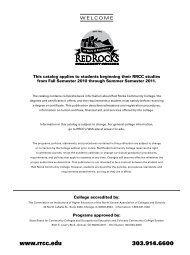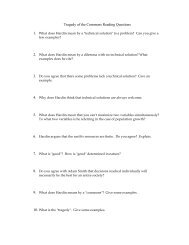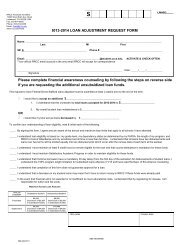opportunities, options, excellence - Red Rocks Community College
opportunities, options, excellence - Red Rocks Community College
opportunities, options, excellence - Red Rocks Community College
Create successful ePaper yourself
Turn your PDF publications into a flip-book with our unique Google optimized e-Paper software.
FMS - FACILITY<br />
MANAGEMENT<br />
FMS 100 Basic Power and Hand<br />
Tools<br />
2 Credits<br />
This course introduces students to application<br />
and safe use of common power and hand<br />
tools used in facilities maintenance. Power<br />
tools such as reciprocating and circular saws,<br />
screw guns and electric and cordless drills are<br />
also discussed.<br />
FMS 102 Facilities Job Skills I<br />
2 Credits<br />
This course is the first of a series that allows<br />
students to become successful in the facilities<br />
maintenance industry. An overview of the<br />
facilities maintenance industry and licensing,<br />
regulations, jurisdiction and certification are<br />
addressed. Other topics include goal setting,<br />
entry-level job skills, acceptable workplace<br />
behavior, interview skills, workplace ethics,<br />
sexual harassment, customer service and<br />
resume writing.<br />
FMS 105 Building Systems I<br />
4 Credits<br />
This course familiarizes students with the<br />
structure of buildings and the systems contained<br />
within them. The building envelope<br />
and the electrical, piping, HVAC and control<br />
systems, as well as how these systems work<br />
together, are covered. The Uniform Building<br />
Code is introduced. This course includes field<br />
trips.<br />
FMS 108 Building Systems II<br />
4 Credits<br />
This course is a continuation of FMS 105,<br />
and helps to bring all the building systems<br />
together. The course introduces advanced<br />
control systems such as DDC and pneumatic<br />
controls. The Uniform Building Code is studied<br />
further. Other topics include indoor air<br />
quality, energy management and the importance<br />
of preventive maintenance.<br />
FST - FIRE SCIENCE<br />
TECHNOLOGY<br />
FST 100 Essentials of Firefighting<br />
(Firefighter I)<br />
5 Credits<br />
Co-requisite: FST 297-402<br />
Prerequisite: FST 102, 103, 105, 106<br />
This course is a classroom section in which<br />
the is taught. Basic firefighting skills in<br />
forcible entry, fire suppression, fire prevention,<br />
equipment and basic fire ground procedures<br />
are covered. This course is required if<br />
students are not presently working in the fire<br />
service.<br />
FST 101 Firefighter II Academy<br />
5 Credits<br />
Co-requisite: FST 297-403<br />
Prerequisites: FST 100, 297<br />
This course involves roughly 360 contact<br />
hours of in-depth training in all aspects of<br />
firefighting. Firefighting skill in fire ground<br />
operations is covered and all required knowledge<br />
and skills are tested for state certification<br />
as Firefighter II. The course is a hands on<br />
intensive and is held at a fire academy training<br />
ground.<br />
FST 102 Introduction to Fire Science<br />
and Suppression<br />
3 Credits<br />
This course presents a broad overview of fire<br />
suppression and prevention in the public and<br />
private sectors. The rudiments of fire history,<br />
building construction, fire behavior, fire<br />
department organization and management,<br />
chemistry of fire, fire and arson investigation,<br />
methods of early detection and suppression,<br />
hazardous materials management, and initial<br />
fire attack, and fire/emergency operations are<br />
studied.<br />
FST 103 Firefighter Occupational<br />
Health and Safety<br />
3 Credits<br />
This course stresses on-scene and on-the-job<br />
causes of firefighter injuries and deaths. Case<br />
studies emphasize the importance of determining<br />
the cause of injury and how to eliminate<br />
those causes. The importance of on-thejob<br />
safety, the safety officer, diet, physical fitness,<br />
mental well-being and stress management<br />
are discussed.<br />
FST 104 Fire Protection Systems<br />
3 Credits<br />
Prerequisites: FST 100, 105 or permission of<br />
instructor<br />
This course provides students with an understanding<br />
of the principles and functions<br />
involved in the installation and use of sprinkler<br />
systems, special suppression systems,<br />
and fire detection and alarm systems.<br />
Students gain a working knowledge of where<br />
these systems are needed in relation to life<br />
safety hazards and various building occupancies<br />
and types of construction. Fire department<br />
involvement in systems maintenance<br />
and use are discussed.<br />
FST 105 Building Plans/Construction<br />
3 Credits<br />
This course provides students with as much<br />
information as possible about the various<br />
methods of building construction, the materials<br />
used in building construction and their<br />
relationship to methods of fire attack and<br />
extinguishment. Using the knowledge<br />
acquired in this course, the firefighter can<br />
greatly enhance the efficiency and ease of<br />
extinguishment and the safety of the firefighting<br />
forces on the fire ground.<br />
FST 106 Fire Inspection Practices<br />
3 Credits<br />
This course provides students with an understanding<br />
of the function, goals and operation<br />
of a fire prevention inspection bureau and the<br />
importance of company inspections and preplanning.<br />
Hazards and the cause of these hazards<br />
and methods to correct them are discussed<br />
in depth. Students are introduced to<br />
classes of building construction, occupancy<br />
hazards, protection systems and devices necessary<br />
to protect buildings and occupants<br />
from hazards to life and property.<br />
FST 107 Hazardous Materials<br />
Operations<br />
3 Credits<br />
Students will study and analyze hazardous<br />
materials incidents, recognizing and identifying<br />
hazardous materials, planning response,<br />
implementing response procedures, decision<br />
making and continued evaluation at the<br />
awareness and operation level.<br />
FST 110 Job Placement and<br />
Assessment<br />
3 Credits<br />
This course introduces entrance firefighter<br />
candidates to a program that they may use to<br />
successfully begin a career in the fire service.<br />
This course discusses the various aspects of<br />
the fire service entrance exam process and<br />
zeros in on the different components of the<br />
exam including the written, physical abilities,<br />
oral interview and resume preparation.<br />
Students learn to identify any deficiencies students<br />
may have regarding various exam topics<br />
and to identify a means to improve in these<br />
areas.<br />
FST 111 Private Fire Protection<br />
Systems<br />
3 Credits<br />
This course is designed to give the non-firefighter<br />
student an insight into the installation,<br />
maintenance and inspection of automatic<br />
detection, suppression and alarm systems.<br />
Special extinguishing systems are also presented.<br />
The criteria that is used to determine<br />
what type of protection system to utilize is<br />
covered in depth.<br />
FST 112 Fire Service Planning<br />
3 Credits<br />
<strong>opportunities</strong>, <strong>options</strong>, <strong>excellence</strong> 142
















